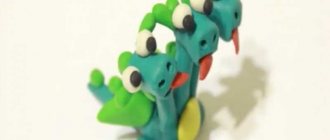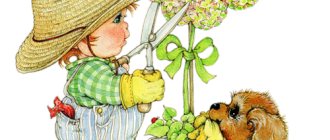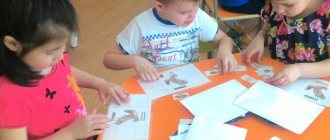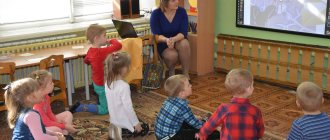Psychological lesson. Topic “We are all so different” lesson plan (senior group)
Author: Kunavina Larisa Yuryevna, teacher of the combined type MADOU “Kindergarten No. 9”, Bogdanovich, Sverdlovsk region
Psychological lesson. Theme: “We are all so different”
Goal: creating a favorable psychological climate in the children's team, developing empathy in children, developing positive communication skills in children, increasing children's self-esteem, harmonizing their internal state, developing children's understanding and feeling for each other.
Materials for the lesson: musical accompaniment, pebbles, a large and small sun according to the number of children, blots, a trash bin.
Progress of the lesson.
Stage 1 - greeting. Exercise “Palms”.
Each child needs to introduce themselves. The first child places his palms on the table and says his name. The next child places his palms on the palms of the previous child and also says his name, etc. As a result, a tower of palms is formed.
Some children are embarrassed to say their name, but over time they overcome their shyness. The exercise helps bring children together.
Exercise “Sprout under the sun.”
Children turn into a small sprout (they curl up into a ball and wrap their arms around their knees), the sun warms up more and more often, and the sprout begins to grow and reach for the sun.
All movements are performed to the music.
Stage 2 - the ritual of “entering” a fairy tale.
Children sit in a circle. They stretch out their palms to the magic ball and close their eyes. They say the words: “One, two, three – come into a fairy tale!”
Stage 3 – reading the fairy tale “Rose and Chamomile”. (Text of a fairy tale from the book by O.V. Khukhlaev, O.E. Khukhlaev. Labyrinth of the Soul. - M.: Academic Project, 2010).
Now I will tell you the fairy tale “Rose and Chamomile”.
“In a small town without a name there was a tiny garden in which a beautiful scarlet rose grew. Not far from her grew a poor defenseless chamomile. It had just blossomed; its petals, which had not yet matured, were white and ordinary. The chamomile was surrounded by many wildflowers. But nothing made her happy. In her tiny head there was a big dream - to become a beautiful, unusual flower. Chamomile looked with admiration at the well-groomed rose. When there was a drought, the owner watered his flower. When it rained, the rose was covered, and not a single menacing drop fell on the velvet petals of the delicate flower. “How good she feels,” thought the chamomile. “I wish I could be in her place,” a small yellow flower with long petals like butterfly wings never stopped dreaming.
But one day a little boy was walking along the path. Seeing the chamomile, he said with admiration: “What a beautiful flower!” At first Chamomile could not understand these words; until that moment she considered herself the ugliest plant. The kid explained to the chamomile that all flowers are good in their own way.”
Discussion of a fairy tale.
1. Why did the daisy look at the rose with admiration?
2. What does it mean “all flowers are good in their own way”?
3. Can this phrase be said about people?
Every person is good in their own way. We are all different: we have different appearance, voice, character. Nowhere, nowhere on the planet is there such a baby as you, there is no such wonderful girl (like ....), there is no such cheerful boy. You are the only one in the world, there is no other child like you.
Let's now try to compliment each other.
- What is a compliment? (children's answers). Yes, you are absolutely right, a compliment is kind, pleasant words spoken to someone. When giving a compliment, they try to talk about the person’s positive traits. What positive qualities does a person have?
Stage 4 – Communication game “Give a pebble”
Take one pebble from the box and give it to whomever you want, but always with the words: “I’m giving you this pebble because you’re the one...” To those children who have nothing left, the presenter gives the pebbles, but always making a note the best qualities of each child to whom he gives a gift.
Stage 5- Psycho-gymnastics “Glue rain”
— Guys, do you like to walk in the warm rain? While we were talking, a gentle rain began to fall. (Children jump joyfully to the music in imaginary rain). The music stops.
— The rain turned out to be not simple, but glue. He glued us together. Sit in a circle on the carpet and hold hands. “Warmth” will go from me to the right, that is, I will gently shake Sasha’s hand, he will shake the next one, and so on in a circle. Let's try. And now do the same thing, but with your eyes closed. Let's see how the group works together.
Stage 6 – Game “We swear at vegetables and fruits”, Game “Trash can”.
Well, the rain has stopped and we can move freely. While we were walking in the rain, we found ourselves in a clearing. There are rude, angry, angry people gathered here who are always swearing, arguing, fighting and calling names. They turned into scary faces and blots. Let's help these people become kinder and more cheerful, and for this we will teach them to swear cheerfully.
Game “We swear at vegetables and fruits”
Children are invited to stand in a circle and scold those standing next to them with a vegetable or fruit (you are a tomato, and you are an orange). It is advisable to pronounce these words angrily, angrily. These actions cause laughter. “You see, we started laughing, and I don’t want to say bad words anymore.”
Garbage Bin Game
Let's get rid of the embodiment of cruelty and anger.
Children are invited to tear into small pieces sheets of paper depicting scary faces and dirty blots. Then trample the anger under your feet, and put the scraps in a garbage bag, tie the bag, and throw it in the trash.
Guys, you and I have spent so much energy with rudeness, anger, malice, so let's take a rest.
Stage 7 – Relaxation game: “In the clearing”
“Imagine a forest clearing in which soft grass grows. Lie on her like a feather bed. Everything around is calm and quiet, you breathe evenly and easily. A wildflower bows its head above you, you can hear the singing of birds, the chirping of grasshoppers. You feel the gentle rays of the sun stroking your cheeks. A gentle breeze tickles you. Whoever feels it opens his eyes.
All this time the sun was watching you. See how it smiles wide for you. Let's smile wide and wide at the sun.
The sun gives you gifts (little suns).
-What can you do with the sun? (children’s answers: “Give to a friend. Draw a smiling face. Tie a string - it will be a kitten toy or a medallion. Make an applique.”)
Stage 8 – generalization of the acquired experience.
The results of the lesson are summed up, the sequence of what happened is recalled, the merits of individual children are noted, the significance of the acquired experience and its connection with real life is emphasized.
Stage 9 – the ritual of “exiting” the fairy tale.
Children sit in a circle. They stretch out their palms to the magic ball and close their eyes.
Teacher: “You can take with you all the most important things you learned in class. One, two, three – get out of the fairy tale!”
Work plan of a preschool educational psychologist
Distribution of indicators of psychological readiness for school at the beginning of the year:
| High level | Average level | Low level | |
| Speech therapy preparatory group "A" | 0% | 75% (3 children) | 25% (1 child) |
| Preparatory group | 20% (5 children) | 56% (14 children) | 24% (6 children) |
The results of the survey showed the need for correctional and developmental work with children with a low level of readiness for school. Consequently, during the year, correctional and developmental work was carried out on the formation of mental processes, arbitrariness, and classes to prepare for school. Recommendations are given to educators and parents on the formation of intellectual, personal and motivational readiness for school.
At the end of the school year, a repeated rapid diagnosis of the level of psychological readiness of children for school was carried out. Thus, from the data obtained it is clear that, in general, pupils of preparatory groups for school are ready to study at school. These results were achieved thanks to the joint work of the educational psychologist and the group teachers.
Distribution of indicators of psychological readiness for school at the end of the year:
| High level | Average level | Low level | |
| Speech therapy preparatory group "A" | 75% (3 children) | 25% (1 child) | 0% |
| Preparatory group | 52% (13 children) | 48% (12 children) | 0% |
Based on the results, we can conclude that corrective developmental work with children who initially have a low and average level of development is effective. Also, it should be noted the need for constant recommendations to parents: to monitor the achievements of their children, to use various techniques for the development of mental processes when communicating with the child at home.
In the period from November to January, a diagnosis of the emotional and volitional sphere of children of older and preparatory groups for school was carried out using the following methods: “Ladder”, “Flower - eight-flowered”. The examination was carried out individually. Preschoolers who have problems were included in the list of children for sessions with a psychologist. Individual consultations were held with parents of children at risk.
Conclusion: according to the results of the research, there is a positive trend in children’s readiness for school. The predicted results of further education at school for all pupils are positive. The overall period of adaptation has been completed and the psychological health of newly arrived children has been preserved.
Psychocorrection and developmental work
Corrective and developmental work with children (individual) was carried out based on diagnostic results, at the request of parents and at the request of teachers. The work used various programs (exercises) aimed at correcting and developing the cognitive, emotional-volitional sphere, and behavioral aspects. Correctional and developmental programs (elements) that I use in my work: A.S. Ronzhina “Psychologist’s classes with children 2-4 years old during the period of adaptation to a preschool institution,” S.V. Lesina; T.N. Snisarenko “Correctional and developmental classes” (a set of measures to develop imagination and reduce children’s aggression), N.L. Kalashnikova “Card index of emotional and educational games” (series “I want to go to school”), G.E. Ovsyannikova “ Path to school" (program of developmental activities). I devote a special focus in my work to art therapy methods. This includes the use of sand therapy, isotherapy, button therapy, and fairy tale therapy. These are methods that allow you to relieve tension, respond to aggressive impulses, and recreate elements of “basic trust in the world.”
Summary of the lesson of a teacher-psychologist in the middle group “Me and my mood.”
Panteleeva Marina Viktorovna
Educational psychologist
MBDOU D/S No. 6 Fairy Tale Municipal District "Baryshsky District"
Lesson summary for the middle group “Me and my mood.”
Target
:
— creating a positive psychological climate among preschoolers;
- learning to understand your own mood;
- development of a sense of collectivism.
- establish friendly, trusting emotional contacts between adults and children.
— to develop the ability to freely express one’s thoughts, develop self-esteem, self-respect, self-acceptance and awareness of one’s “I.”
Progress of the lesson
Educational psychologist
:
-Hello guys! Now we will create a good mood for ourselves and our friends .
I will smile at you, and you will smile at each other.
“It’s great that we’ve all gathered here today.” We are calm and kind, friendly and affectionate. We take turns passing the toy to the neighbor standing next to us and wishing “Good afternoon!” (the game ends when the smile returns to the one with whom the game started, and everyone is smiling).
-Everyone is in a good mood?
Amazing! We sit down more comfortably.
— Guys, a girl named Sasha came to visit us. Look, what’s your mood ?
(picture of a girl with a cheerful face ( Appendix)
).
Do you think Sasha is always in a cheerful mood ?
What are the times when she has fun and is happy? And you? Show your face (facial expressions and movements when you are happy.) Great, well done!
“It’s not at all difficult to recognize a joyful person by his face: he smiles, laughs, the corners of his lips are raised upward, his eyes are narrowed.
—What does a joyful person feel? (children's answers)
. Great!
— A joyful person gains confidence in his own abilities. He feels extraordinary lightness, he wants to fly, dance, jump, scream in order to throw out the joy that overwhelms him.
- Guys, let's show joy together.
The psychologist removes the picture of a girl with a cheerful face and takes out a picture of a girl with a sad face.
- Guys, look, our Sasha’s mood has changed, what’s her mood now? (Application)
That's right sad.
Look at the expression on her face. What happened to her mouth? Eyebrows? What is the look in her eyes? (Children's answers)
.
— A sad person has drooping corners of his mouth and feels weak and unsure of himself.
Game exercise “Different moods ”
The psychologist pronounces phrases and situations, and the children depict the corresponding mood.
The boy broke his favorite car
girl buys flowers for mom,
the little squirrel took the apple from the hedgehog,
the bear is waiting for guests,
Mom gave her son a construction set,
stray dog in the rain,







